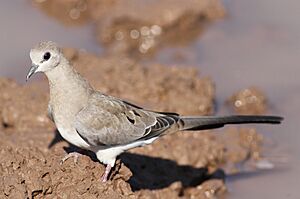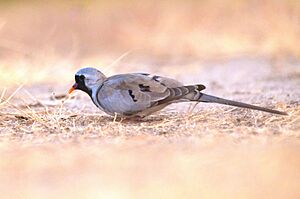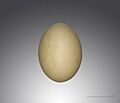Namaqua dove facts for kids
Quick facts for kids Namaqua dove |
|
|---|---|
 |
|
 |
|
| Adult male at Arusha, Tanzania, and a female at Mapungubwe, South Africa |
|
| Conservation status | |
| Scientific classification | |
| Genus: |
Oena
|
| Species: |
capensis
|
| Synonyms | |
|
Columba capensis Linnaeus, 1766 |
|
The Namaqua dove (Oena capensis) is a small, pretty pigeon. It's the only species in its group, called the genus Oena. You can find these doves in many parts of Sub-Saharan Africa, as well as Arabia and Madagascar.
Contents
About the Namaqua Dove's Name
Scientists group living things into categories. This helps us understand how they are related. The Namaqua dove is the only species in its special group, the genus Oena. It's very similar to doves in the group Turtur.
The famous Swedish scientist Carl Linnaeus first described this dove in 1766. He gave it the scientific name Columba capensis. The word capensis means "from the Cape," referring to the Cape of Good Hope in South Africa where it was first found. Later, in 1837, an English scientist named William Swainson created the genus Oena just for this dove. The name Oena comes from an old Greek word for "pigeon." People sometimes call it the Cape dove or long-tailed dove too!
Different Types of Namaqua Doves
There are two main types, or subspecies, of Namaqua doves:
- O. c. capensis: This is the most common type. It lives in sub-Saharan Africa, the Arabian peninsula, parts of southern Israel and Jordan, and on Socotra island.
- O. c. aliena: This type is found on Madagascar. The males of this subspecies have darker heads and backs. Their necks and chests are whiter. They also have thinner black stripes on their faces. Both male and female O. c. aliena are usually a bit smaller than the other type.
What the Namaqua Dove Looks Like
The Namaqua dove is a tiny bird, about the size of a sparrow. It's usually about 22 centimeters (about 8.5 inches) long. Its wings can spread out to 28–33 centimeters (about 11-13 inches). It weighs around 40 grams, which is about the same as a few strawberries! It has a very long, thin black tail. Some people say its shape reminds them of a budgerigar.
Most of its feathers are grey. But its belly is white, and you can see chestnut-colored feathers on its wings when it flies.
The adult male Namaqua dove has a beak that is yellow and red. It also has a black face, throat, and chest. The adult female doesn't have the black markings. Her beak is grey with a red base. Young birds look a bit like the females, but they have dark spots on their wings and shoulders.
Their song is a quiet, short sound that goes kuh-whooo. The second part is longer and higher. It sounds a bit sad and they sing it often.
Where Namaqua Doves Live
These doves live in many places. You can find them all over Sub-Saharan Africa and Madagascar. Their home also stretches into the Arabian Peninsula, southern Israel, and Jordan. They like dry, desert-like areas with acacia trees and bushes.
Sometimes, Namaqua doves travel far from their usual homes. They have been seen in South Asian countries too. For example, one was spotted near Karachi, Pakistan, in 2016. They have also been seen many times near the Nalsarovar Bird Sanctuary in India.
How Namaqua Doves Behave
Namaqua doves spend a lot of time on the ground. They often look for food on open ground and along roadsides. They mostly eat tiny seeds, like those from grasses, sedges, and weeds. They don't usually hang out in big groups. You'll often see them alone or in pairs. However, they might gather in larger groups when they go to drink water. When they fly, they are very fast. They flap their wings quickly and tend to fly low to the ground.
Reproduction and Life Cycle
Namaqua doves build their nests in bushes using sticks.
The female dove lays two white eggs. Both parents take turns keeping the eggs warm, which is called incubation. The eggs hatch after about 16 days. The female sits on the nest at night and in the early morning. The male takes over from mid-morning until late afternoon.
Gallery
-
Egg from Atar, Mauritania -
Roosting male O. c. aliena in Madagascar








